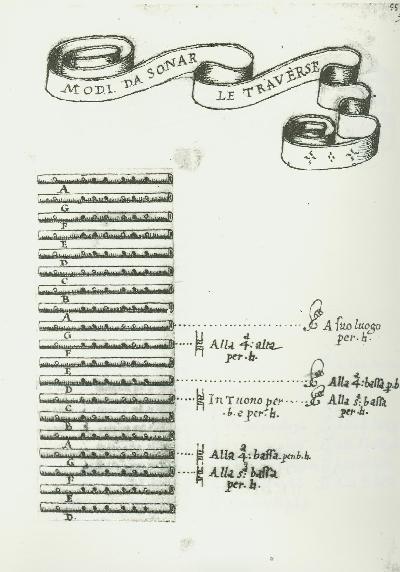

The renaissance flute, the type of instrument used in Europe from roughly 1500 to 1650 and later, was designed to blend well; it was often played with other flutes in a consort, or perhaps with voices or other soft instruments. Yet it can be seen in medium sized and large ensembles, where it presumably played in its high range. It also had military uses, though it is quite likely that the instruments so used may have been of a somewhat different design, perhaps more fife-like.

Shown below are three renaissance flutes by modern makers. The first is after flutes stamped with a trefoil in Verona and is at the original pitch of A=408; the second is modeled on instruments in Brussels, but made at A=440 for the convenience of modern players; the third is a copy of a flute by Rafi and is at the original pitch of A=388.

The renaissance flute is accoustically quite different from six-hole flutes from other traditions and parts of the world. It has a narrow cylindrical bore, and small finger holes and embouchure. This makes the instrument tend to be somewhat quiet and a bit sluggish in the lowest octave, but it is responsive and can be played lightly and delicately in its highest notes. The combination of narrow cylindrical bore and small holes also greatly affects the fingering and resulting sound (see below).
Renaissance flutes were made in several sizes. Three sizes of instruments (that we can call descant, tenor, and bass flutes) are described in several 16th century treatises, though only the two lower sizes are mentioned by Philibert Jambe de Fer (1556). These differed in pitch by a fifth. The lowest notes of the descant, tenor, and bass are, respectively, a', d', and g (though at a pitch somewhat below modern pitch). The middle size, the tenor in d', was the most common size, judging from depictions. But many of the surviving instruments from the 16th century are basses. And no true descants survive, indicating that they were less common (or perhaps more easily lost or broken). Shown below is a modern consort of renaissance flutes (a bass, three tenors, and a descant).

The renaissance flute had a large range for a renaissance wind instrument (at least this is the case for the tenor and descant). Most fingering charts show a range of d' to a''' for the tenor flute. The chart below is taken from Virgiliano (after 1600). What looks like the note B in the chart is not an English language B, but B flat. This can be seen from the fingerings given (which, admittedly, are hard to see in the chart). So the notes F natural and B flat are shown, and not the notes F sharp and B natural that belong to the D major scale.

In the 17th century, one finds evidence of a small renaissance-style flute in g', a tone above the 16th century descant. In partcular, a fingering chart for flute inserted in an edition of Jacob van Eyck's Der Fluyten Lust-hof is for such a small flute. Van Eyck's work was intended primarily for a small recorder with low note c'' (the modern soprano size), and the three lowest notes of the small flute in g' are thus not used at all, while it must regularly play into its third octave.

The design of the renaissance flute, with its small holes on a cylindrical bore, tends to favor harmonic fingerings. The small holes work well as vent holes, but are not ideal for tone holes once you get to the high notes. Much of the second octave is flat if one attempts to use the same fingerings as in the first octave. The fingerings start to diverge significantly with second octave a''. Fingered as 12----, this note is usually intolerably flat unless forced. The correct fingering for a'' is 12-456 (a harmonic of the low d', with hole 3 acting as a vent hole). It does tend to be sharp (shading hole 3 helps to keep it down), but speaks easily and is easy to sustain and shape. One must practice the transition from g'' (fingered 123---, and which tends to be flat) to a''.
(Larger holes, like on the Indian bansuri and modern Boehm flute, even though they have cylindrical bores, allow the fingering 12---- to work for A in both the first and second octaves.)
Why was a narrow bore and small hole design chosen? One can surmise that renaissance listeners prefered the sound that way. Harmonics can sound sweeter. Another reason is that this is simply the best solution renaissance makers found to making a flute that was able to handle the music of the time, based on the materials and technology they had to work with, and the designs they inherited. In any case, if we wish to hear the music as it might have sounded on flutes then, one must use this type of flute.
Renaissance music is based on a variety of 'modes'. The notes appearing in theses modes are the naturals and B flat. (Modes with B flat work better on the renaissance flute than those with B natural.) Other notes are required as musica ficta. While not in most fingering charts, it is easy to produce these with 'forked fingerings', except for the E flat in the first two octaves. This must be produced by covering the first five holes completely and the sixth hole half way, or so, and is difficult. Lowering the breath pressure somewhat—and practice—will help.
Tuning tends towards meantone (true meantone, 1/4 comma meantone). For example, the difference between F# and G in the first two octaves is quite large, while the difference between F# and F natural is small. The difference between c'''sharp fingered as --34-- and d''' as -23456 is large, i.e. more than an equal tempered semitone. There is no fingering that produces a note below d''' but closer to d'''. So one may say that the renaissance flute has a c'''sharp but no d''' flat. Similarly, the fingering 12-4-6 used for a note between d''' and e''' is sharp, i.e. closer to e'''. So we may say that the renaissance flute has an e'''flat, but no d'''sharp.
